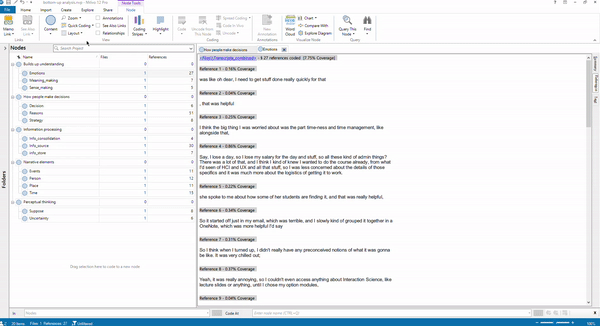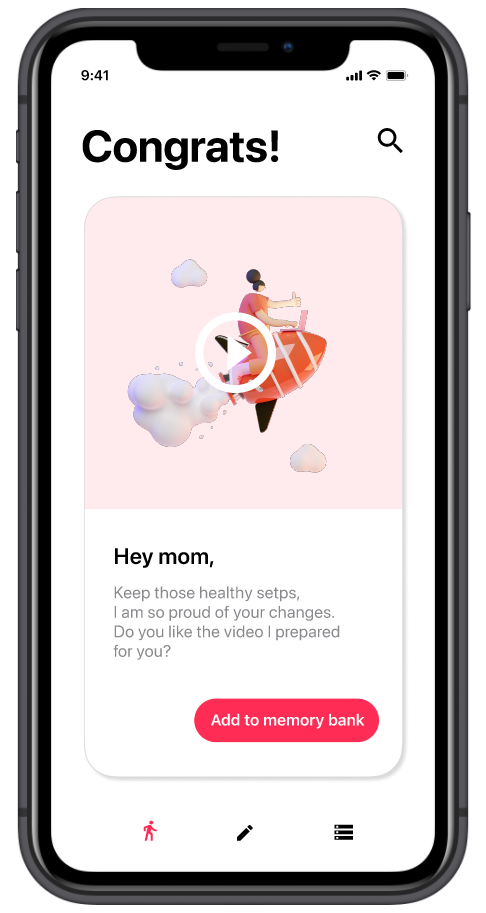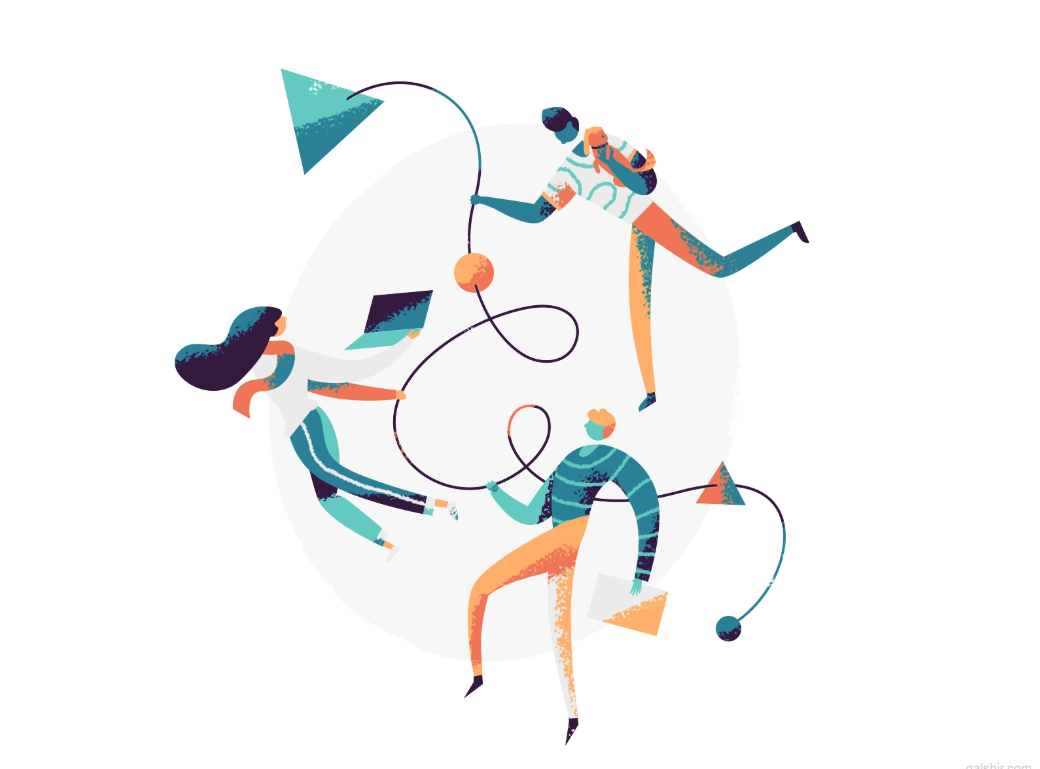Pass🎁on: Cultivating healthy lifestyle in dementia prevention
Our team participated an 30 hours dementia design hackathon which challenging attendees to create an app that can delay or prevent dementia through encouraging lifestyle change, leading to increased quality of life, and prolonged independent living. The results were highly appreciated, as top 3 finalists, by the judges and potential users from greetree program, as well as the officiers from NHS departments for its practical significance to accomodate parents and childrens into a meaningful bond to actively response to healthy lifestyle changing and dementia prevention.
_________________________________________________________________________
Team member: Hongbo Yan, Haichen Gao, Wen Mo, Zeyuan Zhang
Duration: 30 hours, February 2020
Client: Greentree program UK
The problem —
How might we motivate and engage seniors with healthy lifestyle?
People who are lonely and live in isolation are at high risk to have dementia. To prevent dementia, we proposed an app – Passion, to motivate seniors who tend to live those conditions to go outside, become more social and thus have a better lifestyle.
Inspiration —
Engaged with bi-directional trasure hunt games as proactive motivation
Our app inspired by the traditional treasure hunt games. For example, parents can ask their children to perform something fun for them. The challenges could be to sing my favourite song, find my favourite milk, collect 10 lettuces and more. The children take the challenge and hid the request as a gift in different locations, primarily in the places in their parents’ daily routine and then expand to the unexplored territory, for example from the nearby park, the grocery store, to the museums and more.
Solution —
Cultivate healthy lifestyle through completion of meaningful tasks
Our solution is to ask users to complete meaningful tasks together with their loved ones to cultivate healthy lifestyle, including their family members, their friends and their community. By actively associate the health lifestyle and diet with remarkable memories, it naturally forms a strong drive force for the lifesyle change, and thus dementia prevention. As for those activities, they can create and document fun memories with their loved ones.
Process —
Research —
Understanding barriers to make adopable and applicable insights
We started user research from literature reviews focusing on the cause of dementia, what the common digital health interventions are and what applications are currently available in the market. Many types of research mentioned the significance of person-based interventions and social influences.
In the next step we telephone interviewed with people we know whose family members have dementia. From there, we conducted a thematic analysis and focused on the common experience and feedbacks experienced by interviewees.
On the mid-presentations with the professional group, we further inquired them with our initial concepts as well as the problems we were unclear with.
Literature —
Atherogenic diet and sedentary lifestyle are two contributing factors for dementia
From the research, we identify that there is a strong association between midlife cardiometabolic health and the risk for dementia. Intake of high saturated fat diet 🍩 and sedentary lifestyle 💺 are the two contributing factors according to the recent national health survey. It is well established that mid-life atherogenic diet negatively affects cardiometabolic health and therefore contributes to the neuro degenerative disease which may increase the likelihood of dementia. Together encouraged by technological advances, older people may be particularly prone to the negative effects of sedentary lifestyle which is closely associated with memory reduction during aging.
Interview —
Lack of physical exercises and inter-generational bonding further trigger unhealthy lifestyle
Toghther with literature review, our group phone interviewed families lived with dementia members and we transcribed the results using NVivo, an coding software for semantic analysis to locate possible design spaces.
Codes sorting process in NVivo
From the thematic analysis, we further defined three key themes:
Consulting —
How might this solution also benefit in community level ?
We discussed potential solutions with experts, coach and other non-professional members to validate our ideas in detail. From consulting expert who works in dementia research, we refined our original idea and adding the element of community support to include people whose children might be too busy to complete tasks with them or who do not have children.
So they can bond relationships with people who share the same hobbies with them or simply people who are nearby.



Ideation & synthsize —
Diverging to address possibilities,
and converging for idea validation
We sketched and conducted serverl storyboards and brainstorms during ideation process. We scoped down to build a stronger relationship between parents and children with designing fun tasks for them to do together as an intervention to help with mental health. What is more, the tasks naturally could help both sides eat healthily and exercise more.
Ideation —
Brainstorm and affinity daigram to sort out our initial ideas
We sketched and conducted serverl storyboards and brainstorms during ideation process. Through several sessions of idea iteration, we scoped down to build a stronger relationship between parents and children with designing fun tasks for them to do together as an intervention to help with mental health. What is more, the tasks naturally could help both sides eat healthily and exercise more.
Persona —
Our primary stakeholders are seniors live in isolation and with unhealthy lifestyle
Based on the results, we defined our primary stakeholders are people who are 55+, live in isolation and live with unhealthy lifestyle. To narrow down the solutions for potential user, our group summarised and created representitive personas for our final concept.
User journey —
From indoors to grocery stores and outdoors
We drew the full stories lines to depict our stakeholder experience from the very start. They received healthy chellenges, stepped from their places, and walked towards finishing tasks and got the awards.
Design —
Frame user journey with task anatomy
We started user research from literature reviews focusing on the cause of dementia, what the common digital health interventions are and what applications are currently available in the market. Many types of research mentioned the significance of person-based interventions and social influences.
Select task
In the main page of the app, it presents recently added challenges from connections and past finished attempts in the formation of memory bank which allows parents, or children a place for reflection.
Accomplish task
To finish the task, parents or passive task finisher needs to respond to the challenge in order to obtain the rewards. To start a task, simply review the task description and click on scan to locate the object and the embedded messages.
Set task
To set up the surprise, user can self define surprise category, location and object that embedded with, then select responding people and ask them to finish the challenge.
Experience —
Video prototype in real scenarios
To better pitch our concept and create immersive user experience, our team commited to deliver the whole user jouryney just before the presentation.
Takeaways —
Why this apporach is technologically feasible?
To build our app, it requires coding with C++, Android Studio and basic object detection algorithm. There are a lot of open resources, for example, Teachable Machine. Therefore, We believe it is highly feasible to build it within 6 month-time frames.
Why it can motivate people’ engagement and induce behaviour change?
To search for the challenges or the gifts itself is a good way to get exercise and physically active.
The designing aspect of the game is a natural way to get mentally active.
From buying healthy food in the grocery store we also associate the product with a warm memory you share with your loved ones and it can become a strong motivation for them to continue with this behaviour.
By doing activities together, it is also a very good way for senior users to not just play a passive role in the interventions, but also the active one that contributes to the life of their loved ones.
How to involve a wider audience?
Last by not least, this app also has the potential to expand to a much larger audience. The nature of fun tasks can attract a lot of people from different background. It also works for people who live in two different cities or even two different countries. The app can become a fun and interesting digital health intervention for people around the world.















